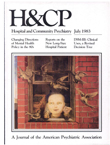The "Chronic" Mental Hospital Patient
Abstract
The rapid decrease in the resident population ofstate hospitals over the last decade has engendered a debate over the future role of the state hospital in the overall mental health services system. The authors report on a 1979 study of more than 2,000 state hospital patients designed to evaluate the characteristics of the current hospital population. Theirfindings document the existence ofa new long-stay population that in many ways is similar to the old long-stay population that existed before deinstitutionalization. Continued hospitalization of the new population of long-stay patients, who now are younger than the old long-stay patient group, could cost more than $ 500 million dollars a year. The authors discuss the difficulty in predicting future trendsfrom the existing data and outline four areas for future re-search.
Access content
To read the fulltext, please use one of the options below to sign in or purchase access.- Personal login
- Institutional Login
- Sign in via OpenAthens
- Register for access
-
Please login/register if you wish to pair your device and check access availability.
Not a subscriber?
PsychiatryOnline subscription options offer access to the DSM-5 library, books, journals, CME, and patient resources. This all-in-one virtual library provides psychiatrists and mental health professionals with key resources for diagnosis, treatment, research, and professional development.
Need more help? PsychiatryOnline Customer Service may be reached by emailing [email protected] or by calling 800-368-5777 (in the U.S.) or 703-907-7322 (outside the U.S.).



